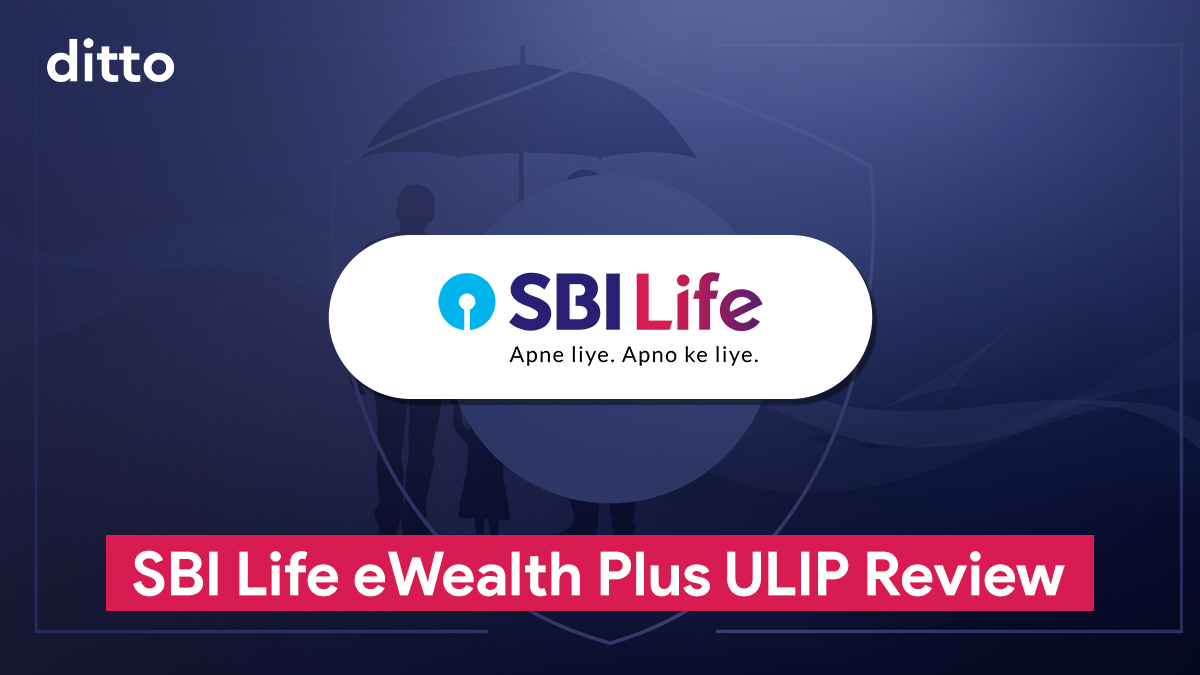SBI Life eWealth Plus is positioned as a ULIP (Unit Linked Insurance Plan) that combines “wealth creation with protection.” The marketing pitch highlights its zero premium allocation charges, automated investment strategies, 12 fund options for your portfolio, and the dual benefit of investment and life cover. But does it deliver real value?
At Ditto, we talk to thousands of buyers weighing ULIPs against simpler alternatives like term insurance + mutual funds. For this piece, we dissected the official policy brochure and benchmarked eWealth Plus against leading competitor policies. By the end, you’ll know where eWealth Plus stands on life cover, costs, investment flexibility, and real-world usefulness—so you can decide whether to buy it or pick a better alternative.
Still unsure? Speak to a Ditto advisor before locking yourself into a 10–20 year ULIP. They’ll help you figure out whether a ULIP even makes sense for your financial goals—or if you’re better off keeping insurance and investments separate.
Quick Overview: What Is SBI Life eWealth Plus?
SBI Life eWealth Plus is an online Unit Linked Insurance Plan (ULIP) that combines long-term market-linked investments with basic life cover. It offers two investment strategies, giving you flexibility based on how hands-on you want to be with your investments. For basic features, such as policy term, premium payment term, and entry age, please refer to pages 4 and 5 of the policy brochure.
Some of the features presented as headliners in the policy brochure include:
1) Life Coverage + Market-Linked Returns
Enjoy the security of life insurance while your money grows through market-linked investments.
2) Choice of Two Investment Strategies
Pick an approach that suits your style—Growth Strategy for a hands-off, automated allocation or Active Strategy for complete control over your investments.
3) Nominal Premiums with Zero Allocation Charges
Your entire premium works for you—no deductions for allocation charges.
4) Partial Withdrawals from Year 6
Access a part of your funds when you need them, starting from the 6th policy year.
SBI Life eWealth Plus: Life Cover and Market-Linked Growth
SBI Life eWealth Plus’ maturity benefit is pretty standard (and even a little bare-bones): you receive your fund value at the end of the policy term. There are no guaranteed additions, no loyalty bonuses, and no return-of-mortality-charge benefits, just whatever your investments have grown to after deducting all applicable charges.
The death benefit is also unremarkable, defined as the highest of the following:
- Fund Value (as on the date of intimation)
- Sum Assured (which is fixed at 10× the annual premium) minus applicable partial withdrawals
- 105% of total premiums paid up to the date of death
To put into perspective, a ₹1 lakh annual premium into the EWealth Plus plan gets you a life cover of ₹10 lakh. In contrast, if you spent that same ₹1 lakh on a term plan, you could get protection of ₹1 crore or more, and still have money left over to invest wherever you like. That’s a huge difference.
Also note that some ULIPs, such as HDFC Life Sampoorn Nivesh Plus, offer benefit variants that allow higher life cover along with benefits like return of premiums, which SBI Life eWealth Plus does not provide.
Ditto’s Verdict:
While SBI Life eWealth Plus combines investment and protection in theory, the insurance element is weak. If your priority is life cover, a separate term plan is a far superior option. This ULIP only makes sense if your main goal is long-term investment with a bundled insurance component and you’re comfortable with the charges and lack of flexibility.
SBI Life eWealth Plus: Investment Strategies
SBI Life eWealth Plus gives you two ways to invest—Growth Strategy and Active Strategy. Both sound good on paper, but let’s break it down.
Growth Strategy (Automatic Asset Allocation)
Think of this as the “autopilot” option. Early on, most of your money sits in equities (up to 80%) for growth. As you near maturity, it shifts to debt and money market instruments to reduce risk.
Pros:
- Great for hands-off investors.
- Reduces volatility as the policy ages.
Cons:
- You can’t change the glide path. If markets tank midway, you’re stuck.
- No option to switch to Active Strategy later.
Active Strategy (DIY Fund Picks)
Here, you choose from 12 funds—from high-risk equity (Midcap, Pure Fund) to safer debt (Bond Fund). You also get 2 free switches a year. To get the full list of fund options, check out pages 10 to 14 of the policy brochure (linked above).
Pros:
- Full control for savvy investors.
- Unlimited premium redirection.
Cons:
- Only 2 free switches; more will cost you.
- Needs regular monitoring.
Ditto’s Verdict
Growth Strategy works for those who want zero involvement. Active Strategy suits DIY investors, but you’re locked into your choice for the entire policy term.
The “12 fund options” sound big, but most people stick to 2–3 based on their risk appetite. Aggressive investors lean toward equity-heavy funds like Midcap Fund, Pure Fund, or Bluechip Fund. Balanced investors often choose the Balanced Fund or the Bond Optimiser Fund for a mix of equity and debt. Conservative investors stick with a Bond Fund or Corporate Bond Fund for stability.
If your main goal is wealth creation, direct mutual funds do the same job with lower costs and more flexibility. Remember, ULIPs like eWealth Plus are insurance + investment hybrids; they rarely beat a term plan + mutual fund combo.
SBI Life eWealth Plus’ Zero Premium Allocation Charge: Real Benefit or Gimmick?
One of SBI Life eWealth Plus’ biggest selling points is “Zero Premium Allocation Charge”, which sounds great because it means your entire premium is invested from day one without upfront cuts. And yes, this is better than older ULIPs that used to deduct 8–10% as allocation charges in the early years.
But before we delve deeper, let’s look at the charge structure:
| Charge Type | Amount / Method |
|---|---|
| Premium Allocation Charge | ₹0 |
| Policy Administration | ₹100/month = ₹1,200/year (max ₹500/month cap) |
| Fund Management Charge (FMC) | 0.25% – 1.35% per annum, deducted daily from fund NAV |
| Mortality Charge | Based on age & sum at risk, deducted monthly by unit cancellation |
| GST | 18% on mortality + admin + switching/withdrawal charges |
| Switching Charge | 2 switches/year free, ₹100 per extra (max ₹500) |
| Partial Withdrawal | 1 free/year from year 6 onwards; ₹100 per extra (max ₹500) |
| Discontinuance Charge | Applies only in the first 4 years; 0 after the 5th year |
| Surrender Charge | Nil after 5 years (fund value paid) |
| Top-up Charges | Top-ups not allowed |
Ditto’s Verdict:
On pure charges and flexibility, SBI Life eWealth Plus is mid-pack. It’s cleaner than older, fee-heavy ULIPs but inferior to the top online competitors that either don’t levy ongoing admin/switch fees or refund charges/add boosters for stayers.
And while the zero allocation charge promise is true, it does not mean zero deductions. Your premium still faces policy administration charges, mortality charges, and fund management charges, which will eat into your returns over time. In essence, when more of your premium gets invested in the early years, the recurring charges keep pulling the value down year after year. So unfortunately, the zero allocation charge is more of a gimmick than a real benefit.
SBI Life eWealth Plus: Partial Withdrawals
Yes, but only after the mandatory 5-year lock-in (a rule for all ULIPs). From year 6, you can withdraw money, but with limits:
- Up to 15% of fund value
- Minimum ₹5,000 per withdrawal
- Fund value after withdrawal must stay above 50% of total premiums paid
- Each withdrawal reduces your life cover proportionately
This offers some flexibility in emergencies, but frequent withdrawals can hurt growth and shrink your cover.
How does it compare to other ULIPs?
Most ULIPs allow withdrawals post lock-in, but some like HDFC Life Click 2 Wealth or ICICI Pru Signature give more freedom (e.g., unlimited withdrawals without reducing bonuses). SBI Life eWealth Plus lacks such perks.
Ditto’s Verdict:
Partial withdrawal is a standard ULIP feature, not a unique advantage here. If liquidity is a priority, you’re better off with term insurance + mutual funds, where your money isn’t locked in for 5 years, and you can access it freely.
SBI Life eWealth Plus vs Other Popular ULIPs
When you stack SBI Life eWealth Plus against other leading ULIPs, its strengths and weaknesses become clearer.
Loyalty Additions:
SBI Life eWealth Plus offers no loyalty additions, fund boosters, or charge refunds at any point in the policy term. In contrast, plans like ICICI Pru Signature refund policy admin charges every 5 years, and HDFC Click 2 Wealth refunds mortality charges at maturity. Some ULIPs, like SBI Life Smart Privilege Plus, even start adding loyalty units from year 6. eWealth Plus doesn’t, which makes it less rewarding for long-term investors.
Life Cover Efficiency:
Like most ULIPs, eWealth Plus offers only the IRDAI-mandated minimum coverage (10 times the annual premium). There are no benefit variants for enhanced protection. Other ULIPs, such as HDFC Sampoorn Nivesh Plus and ICICI Pru Signature, offer variants with higher sum assured or return-of-mortality-charge features, making them more cost-efficient over time.
Fund Choices and Switching:
Under Active Strategy, eWealth Plus gives you 12 fund options, which is decent, but competitors like HDFC Click 2 Wealth and Bajaj Allianz Goal Assure II offer more fund options with unlimited free switches, while SBI Life caps free switches at 2 per year. That can be a disadvantage for active investors.
Volatility Management:
The Growth Strategy in eWealth Plus is a basic life-cycle allocation that gradually shifts from equity to debt. Other ULIPs, like ICICI Pru LifeTime Classic, also offer similar auto-rebalancing strategies, often paired with earlier loyalty additions or lower charges, making them more appealing. Another standout is Canara HSBC’s Promise4Growth Plus, which not only auto-rebalances to maintain the equity–debt mix but also includes a Safety Switch that shifts funds to debt in later years, providing enhanced volatility management.
Zero Allocation Charges:
Plans like HDFC Life Click 2 Wealth and ICICI Pru Signature also offer zero allocation charges, but they go a step further by refunding mortality charges or policy admin charges, making them more cost-efficient over the long term. SBI Life eWealth Plus doesn’t offer such refunds, so its “zero allocation” advantage is limited.
SBI Life eWealth Plus: Ditto’s Take
SBI Life eWealth Plus is a low-frills ULIP with zero allocation charges and simple investment options, but it doesn’t really outshine peers. It lacks loyalty benefits, charge refunds, or enhanced protection options that competitors provide.
It delivers on the basics: market-linked growth, regulatory-compliant life cover, and two investment approaches (Growth and Active). But upon closer examination, the picture is less impressive. In short, it’s a plain-vanilla ULIP in a market where competitors like HDFC Click 2 Wealth, ICICI Pru Signature, or Bajaj Allianz Goal Assure II pack in more investor-friendly features.
So if you’re considering a ULIP for long-term investment, these alternatives might deliver better overall value. However, if your primary goal is wealth creation, you’re almost always better off combining a pure term plan with mutual funds for higher returns, flexibility, and stronger protection. But if you still want a ULIP, compare across insurers before committing.
Still unsure? Speak to a Ditto advisor before locking yourself into a 10–20 year ULIP. They’ll help you figure out whether a ULIP even makes sense for your financial goals—or if you’re better off keeping insurance and investments separate.
Last updated on:










